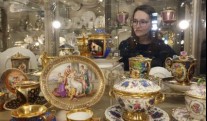Господдержка предприятий-производителей строительных материалов

The Nizhny Novgorod State Historical and Architectural Museum-Reserve welcomed the spring with a long-awaited event - after a long break, the third floor of the Rukavishnikov Estate opened. The open storage of the museum's richest collections of porcelain and glass is now permanently located there: everything that was previously hidden from prying eyes in the basements is now available for viewing.
In the summer, the museum presented viewers with open storage of the metal fund, and now the time has come for porcelain. The exhibition is formed according to a chronological principle: from ancient Greek ceramics to porcelain of the 16th–19th centuries.
“More than 2,000 items are on display here. We start with ancient Greece, this is the 6th century BC. Then it goes chronologically: China, Japan, Italian majolica, Venetian glass, then England - 18th century, Holland, France 16th-18th centuries. Russian Gzhel fits into the exhibition separately,” said Olga Yakovuk, curator of the porcelain and glass collection.
The world-famous Meissen porcelain, the products of the first manufactory in Europe, which for a long time was a leading enterprise, is also widely represented in the display cases. Here you can also see exquisite tableware created in factories in Dresden, Vienna and private manufactories.
The porcelain collection in the historical and architectural museum-reserve includes about 7,000 exhibits.
The authors of the exhibition devoted special attention to porcelain created at the Imperial Porcelain Factory of St. Petersburg and unique porcelain from the famous “Kamensky treasure”. It was discovered by chance during the renovation of a mansion on Verkhnevolzhskaya embankment in 1973.
“When the engineer was measuring the walls, he realized that there was a hidden niche somewhere, and discovered a cache in which a lot of porcelain was hidden, which we now have on display in a separate showcase,” shared the director of the museum-reserve, Yuri Filippov.
You can also see the famous “Vershininsky” glass in the exhibition. These were made in the 19th century at the glass factory of Alexei Bakhmetev by master Alexander Vershinin. These were products with double walls, between which the master placed entire paintings made of paper, moss and straw. It still remains a mystery how the master attached the compositions to the glass and sealed the walls of the glass. Only eight “Vershinin” glasses are currently known in museum collections in Russia, but there are 18 of them all over the world.
The glass of the Nizhny Novgorod museum comes from the collection of the famous Nizhny Novgorod artist and photographer Andrei Osipovich Karelin. There are also other unique exhibits in the collection - many of them exist in a single copy.
And 13 objects displayed in the new showcases have just returned from the restoration workshops of the Grabar Center. Including a Florentine mirror from the first quarter of the 18th century, the frame of which is decorated with smalt mosaics. You can visit the open storage of the porcelain and glass collection every day from Tuesday to Sunday, twice a day.
Source: https://pravda-nn.ru/